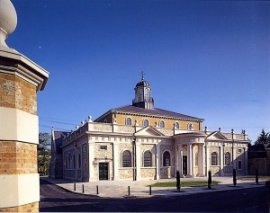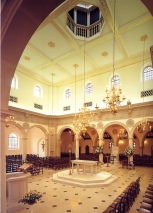

![]()

|

|


![]()

|

|
|
The first building that was used as a Catholic Church on this site was an early 19th century brick building now occupied by a Social Centre. Later in the 19th century a stone Gothic Revival Building was erected. When the Church became a Cathedral it was extended by a large modern building in the 1970s built in reinforced concrete, which proved unsatisfactory. The new Cathedral replaces the 1970 building entirely and is built alongside the Gothic Revival Church to form an elongated Maltese Cross plan, the old Nave becoming the Chancel with transepts on all four sides. In the Nave the spacing of the columns is dictated by the exisiting column shafts which remain on the south side but were removed in the modern extension; they have now been replaced. The arches rest on simple Tuscan columns forming an arcade supporting the whole of the central space. At the corners of this arcade are coupled giant Doric pilasters with entablature, complete with triglyphs and metopes which run round the whole of the central space; this is also the main architectural element of the exterior.
Externally, the same giant Doric order is expressed by pilasters on the north and west elevations. The centre bay of the main entrance on the north elevation forms a portico inspired by the south portico of St Paul's Cathedral and St Mary-le-Strand.
Architecturally, the inspiration is early Italian Renaissance crossed with the English Baroque of Christopher Wren. The Doric Order is Bramantesque Palladian; the arcade is obviously influenced by Brunelleschi and the cupola is inspired by Bernini's Church in Ariccia. However, the windows have characteristically English lead cames fixed to bronze saddle bars with small panes; the clerestory is faced in Smeed Dean stock brickwork, the roof is Welsh slate. The juxtaposition of classic and Gothic elements in the west elevation, and the view if Gothic arches seen through a classical arcade are inevitable in any building which has a long history. All five Orders have been employed in the design; Tuscan for the arcade, Doric for the main giant Order, Ionic for the east and west Serlian windows, Composite and Corinthian for the organ and cathedra. |